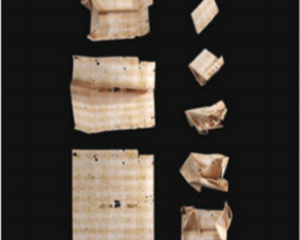Hacking history
黑客史
Origami in reverse
逆向折紙
Cracking the security on a trove of 17th-century letters
撬開一堆17世紀的信件
A modern correspondent wanting to communicate privately can use computerised encryption. Three hundred years ago, origami would have been a better bet.
想要私下溝通的現代通訊記者可以使用計算機加密。三百年前,折紙可能是個更好的選擇。
Before gummed envelopes became common in the 1800s, letters were posted with no security wrapper. Privacy-minded writers relied instead on cunning combinations of folds, tucks, slits and seals, a practice Jana Dambrogio at the Massachusetts Institute of Technology has dubbed "letterlocking".
在19世紀涂膠信封普及之前,信在投遞時并沒有安全性包裝。注重隱私的作家們轉而依靠巧妙的折疊、褶子、縫和封條的組合,麻省理工學院的讓娜·丹布羅吉歐稱之為“信鎖”。
Some, like the "chapel fold", in which the letteris turned into its own envelope and sealed, were the equivalent of simple padlocks. Others were subtler. The "dagger trap"relied on a concealed wax seal that would leave a telltale rip once a letter had been opened.
有些就像“教堂褶”,把信放進信封并密封起來,就像簡單的掛鎖一樣。“匕首陷阱”依賴于一個隱藏的蠟封,一旦信被打開,就會留下一個泄密的裂口。
But information about the practice is scarce. Most historical letters survive in their opened form, leaving aficionados like Ms Dambrogio with little to go on but crease-marks and tears. The few that remain unopened present a different problem: how to read them without permanently damaging the letterlock. Now, in research published in Nature Communications, Ms Dambrogio and her colleagues have come up with a solution.
但是有關這種做法的信息很少。大多數歷史文獻以公開形式保存下來,這讓像丹布羅吉奧這樣的愛好者除了折痕和裂縫外幾乎沒有任何進展。少數未開封的信件則呈現出另一個問題:如何在不損壞信鎖的情況下讀信。目前,在《自然通訊》上發表的一項研究中,丹布羅吉奧女士和她的同事們想出了一個解決方案。

The letters in question are part of the Brienne Collection, a trove of thousands of undelivered 17th-century letters bequeathed to posterity by Dutch postmasters. The collection includes 577 unopened, letterlocked missives. To get at their letters' contents while preserving the integrity of the locks, the team turned to X-rays and computers.
這些信件屬于布蕾妮的藏品,這些藏品是荷蘭郵政局長留給后人的數千封17世紀未投遞的信件。藏品中包涵577封未開封的信件。為了在保持信鎖的完整性的同時讀取信件的內容,該團隊使用了X光和電腦。
The key lay in knowing that the inks used at the time often contained iron. This meant that an X-ray microtomography scanner, of the kind usually reserved for distinguishing teeth or bone from soft tissue, could reliably distinguish the metallic letters from the paper background. Once the scan had also revealed the topography of the sheet, with the location of folds and creases mapped, the resulting model could be virtually unfolded by a computer to reveal the hidden text.
關鍵在于知道當時使用的墨水中通常含有鐵。這意味著,通常用于區分牙齒、骨頭和軟組織的X光顯微斷層掃描儀能可靠地從紙張背景中分辨出金屬字母。掃描一旦顯示出紙張的的形態,并標出褶皺和折痕的位置,那么可以通過計算機將得到的模型展開來揭示隱藏的文本。
Though some imperfections remain—a hole left by a burrowing worm, for example, or the dry scratch of an ink-free nib—the legibility of the scans rivalled anything one would find in a research library, says Dr Starza Smith, a researcher at King's College London. And although no spectacular secrets have yet emerged from the Brienne Collection, the technique seems to hold plenty of promise for future research into a fascinating historical practice.
倫敦國王學院的研究人員斯塔扎·史密斯博士說,盡管還存在一些缺陷——例如,穴居蟲留下的洞,或者無墨水筆尖上的干劃痕——但掃描結果的易讀性比得上在研究圖書館里找到的任何東西。雖然還沒有從布蕾妮的藏品中發現什么驚人的秘密,但這項技術似乎為未來研究這一迷人的歷史實踐提供了很多希望。
譯文由可可原創,僅供學習交流使用,未經許可請勿轉載。











